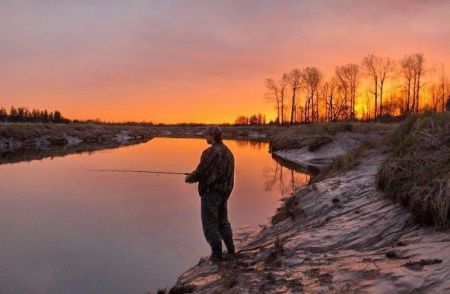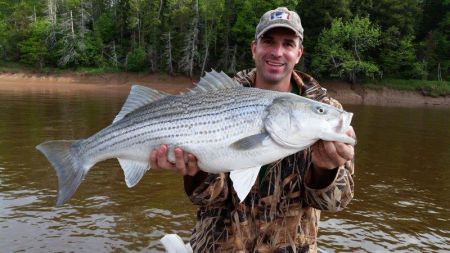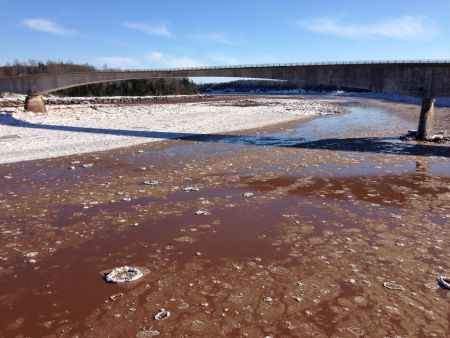"For the last 20 years we've been hearing about what a special place we live in. And now we're going to dump in the middle of it."
"We don't want another Annapolis Royal. They used to have huge fish. In 20 or 30 years, are we going to look back and say, oh god, we shouldn't have done that?"
"If we lose one part of the food chain, we lose the bass."
These were some of the comments and questions coming from the floor at the Striped Bass Association's Annual General Meeting in Stewiacke on Thursday. The questions were directed to Department of Fisheries and Oceans (DFO) representative Greg Stevens, who was there to answer the Striped Bass Association (SBA) members' concerns about Alton Gas Storage, a natural gas storage company that received a permit from the Nova Scotia Department of Environment in January to build underground storage caverns for natural gas in Brentwood, Nova Scotia. The caverns are currently natural salt caverns, which Alton Gas plans to empty of the mineral by diverting water from the Shubenacadie River into the caverns to dissolve the salt, and then discharging the brine waste into holding ponds and finally back into the river.
Striped bass is an endangered species under the Committee on the Status of Endagered Wildlife in Canada, and the Shubenacadie River is the last striped bass spawning ground in Nova Scotia. Five thousand First Nations and non-Native anglers in the province fish striped bass for food and recreation.
The 35 or so people who gathered in Stewiacke on Thursday were overwhelmingly opposed to Alton Gas Storage's impending project, and much of the frustration was centered on what they expressed to be an unacceptable process of granting a permit to a company whose operations threaten a unique and valuable ecosystem.
"We've been trying to meet with people since 2014, and it's only now that we're being told the project is going ahead," said Willie Courtney, president of the Shubenacadie River Commercial Fishermen's Association (SRCFA), who was in attendance at Thursday's meeting. The SRCFA represents about 20 people with active licenses who depend on the Shubenacadie River for a livelihood.
When the SBA and the SRCFA were made aware in 2014 that the Alton project was starting, members tried in vain to meet with decision-makers at DFO and the provincial Departments of Environment and Natural Resources, as well as Alton Gas, to express their concerns as stakeholders in the river. There has been no reply from government to their request. Alton, in a FAQ sheet released in February 2015, says it met with representatives of the Striped Bass Association on October 15, 2014. The association maintains that no such meeting took place.
The Shubenacadie River is not only important as a striped bass spawning ground, but it is one of the most diverse rivers in the province in terms of commercial, recreational and food fishing. Shad, eels and gaspereau are fished commercially in the Shubie, and along with smelt, salmon and sturgeon, these fish as well as the smaller fish down the food chain all spawn in the tidal ecosystem of the Shubenacadie and Stewiacke Rivers.
The environmental assessment performed by Alton Gas is, according to SBA members, incomplete. It depends on Masters theses done by students at Dalhousie University's Agricultural Campus in Truro--projects that were paid for and edited by Alton Gas before they were used for the company's environmental assessments. As outlined in Miles Howe's recent investigative report for The Coast, these studies, which focus on the impact of increased salinity from the brine waste on bass eggs and larvae, do not draw conclusive evidence for a safe salinity concentration on the eggs. Nor does the assessment address the impacts of salinity on any other species in the river.
The assessment also fails, according to association members, to consider the delicate and unpredictable nature of the tidal ecosystem. The Bay of Fundy, which sees the highest tides in the world, creates surges of salt water in and out of the Shubenacadie river, bringing fish up and down stream, creating whirlpools, rapids, eddies and sandbars. Tidal action is also the mechanism by which Alton Gas intends to flush the contents of its caverns into the bay, and eventually the ocean. But the fishermen say that the company's plan will not work.
"By observation, we believe that the salt will drop into eddy holes," said Courtney in an interview prior to the SBA meeting. "If we lose a boat, we look upstream…deposits on the bottom always move upriver."
"It's a guessing game," said Art Redden of the Striped Bass Association in a phone interview. "They think it's like flushing a toilet, but mother nature doesn't work like that. It's 25 kilometers [downstream] from the pumping station to the Bay," and Alton's brine will have to contend with a system that moves everything "five miles upstream," according to several SBA members who spoke on Thursday.
SBA members said they are uncomfortable with the monitoring of Alton Gas' operation, which will be performed by the company itself, by computer, with no human oversight. They also said that the reporting process for the results of the monitoring is inadequate to prevent damage to the river should something go wrong. Alton must report monthly to the Department of the Environment for the first four months of activity, and quarterly thereafter. Reports must be submitted within 30 days of the reporting period. SBA membership say that means that if something goes wrong after the first four months of Alton's activity, it could be five months before the province finds out about it.
Association members pointed out that the region around the proposed caverns is prone to storms, flooding and high winds. There, brine waste at concentrations of 260 parts per thousand (lethal to fish and eggs) will be stored in holding ponds before being released into the river (at concentrations of not more than 28 parts per thousand). In 2015, the area flooded four times, with water reaching above the tires of Alton Gas Storage company equipment onsite at the time, and well above the holding ponds' dykes.
The Bass Association wanted to know why DFO has not stepped in to prevent approval by the province of the Alton Gas project, given the federal department's mandate is to uphold the Fisheries Act, and given what members feel to be overwhelming evidence and traditional knowledge about the delicate nature of the Shubenacadie and Stewiacke Rivers and their ecosystem. Section 35 of the Fisheries Act says, "No person shall carry on any work, undertaking or activity that results in serious harm to fish that are part of a commercial, recreational or Aboriginal fishery, or to fish that support such a fishery."
"We can't say no [to the project]. We're not the licensing body," said DFO's Greg Stevens. In other words, DFO can advise the Nova Scotia Department of the Environment on a given permit, but it cannot veto one. "We can't stop anything until something goes wrong. So far, there's been no offense."
It is unknown what advice DFO offered the Department of Environment that resulted in Alton Gas' permit being granted. Mark McLean, the officer in charge of the Alton Gas file, was unable to attend Thursday's SBA meeting due to illness.
The province says the Alton Gas Storage project will save Nova Scotians $17 million by making natural gas available, but many say that the savings will go to big natural gas consumers in the province like Irving and Nova Scotia Power, and rural people—who will be most affected by the project—will not benefit. When asked if he would support Alton's project if the caverns could be built with no impact on the river, Willie Courtney said, "The overall project is of no value for Nova Scotians. We don't need the project. It's all for someone else, not Nova Scotians."
"Mining and gas companies have identified over 600 sites from Digby to Stewiacke for fracking holes," said Art Redden. "This is for fracking gas"—as in, Alton's caverns are potential storage infrastructure for a local fracking industry.
"And look at the property values" of the people around Brentwood, he said. "Who's going to buy their property if they want to sell? They haven't dealt with those issues. The whole process is flawed."
At a Stewiacke Town Council meeting the same night as the Striped Bass Association's AGM, council was scheduled to vote on accepting a donation of $100,000 from Alton Gas Storage. A motion to look into the donation was made, but could find no seconder.
Moira lives and writes in Maitland.
CORRECTION: It was incorrectly reported in the original publication of this article that Acadia University students' work was paid for and used as Alton Gas Storage's environmental assessment. Acadia's striped bass tagging program does not operate in the Shubenacadie River, and never received funds from Alton. It was rather Dalhousie University's Agricultural Campus in Truro that performed and published the studies.





